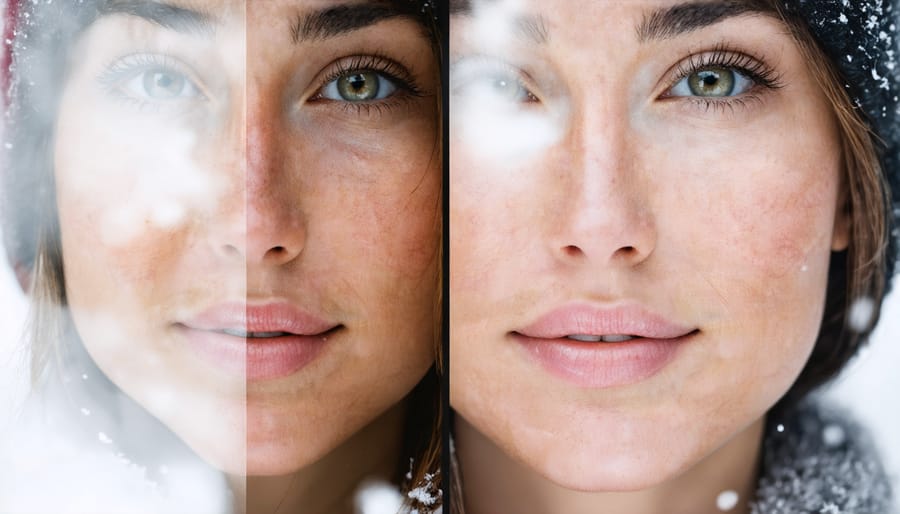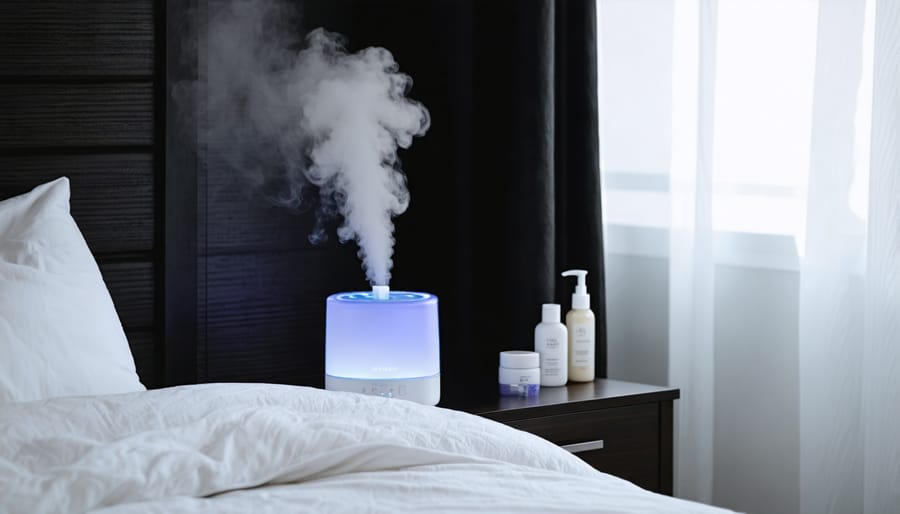
When winter winds howl and temperatures plummet, your skin faces its toughest battle of the year. Leading dermatologists reveal that establishing the right skincare routine during these harsh months can make all the difference between dry, flaky discomfort and healthy, glowing skin.
As someone who’s struggled with winter-worn skin (and consulted countless dermatologists), I’ve learned that protecting your skin during cold months isn’t just about slathering on moisturizer. It’s about understanding how winter’s unique challenges – from icy winds to indoor heating – affect your skin’s natural barrier.
Dr. Sarah Chen, a board-certified dermatologist specializing in seasonal skin transitions, explains: “Winter demands a complete shift in how we care for our skin. The combination of cold outdoor air and dry indoor heat creates the perfect storm for moisture loss and irritation.”
Whether you’re battling red, chapped cheeks or dealing with flaky patches, the expert-backed tips in this guide will help transform your winter skincare routine from basic to brilliant. Let’s dive into the dermatologist-approved strategies that will keep your skin healthy, protected, and radiant throughout the coldest months of the year.
Why Winter Changes Everything for Your Skin
The Science Behind Winter Skin Damage
Ever wonder why your skin feels extra dry and sensitive during winter? It all comes down to science. Our skin has a natural moisture barrier – think of it as your skin’s protective shield – that helps lock in hydration and block out harmful elements. When winter hits, this barrier faces quite a challenge! Just like you need to determine your skin type to care for it properly, understanding these winter challenges is crucial.
The main culprit? Low humidity levels. When cold outdoor air meets indoor heating, it creates the perfect storm for moisture loss. Think about it like a sponge in a dry environment – it quickly loses its moisture to the surrounding air. Your skin responds similarly, with the water in its outer layer evaporating more quickly than usual.
Environmental factors like harsh winds, sudden temperature changes, and indoor heating systems further compromise your skin’s barrier. These conditions can lead to microscopic cracks in the skin’s surface, making it more vulnerable to irritation and dryness. It’s like your skin’s natural defense system is working overtime, but without the right support, it just can’t keep up with winter’s demands.
Common Winter Skin Issues
As someone who’s experienced the winter skin struggle firsthand, I know how challenging these cold months can be for our complexion. The most common issue during winter is excessive dryness, which often shows up as flaky, tight-feeling skin that seems to drink up moisturizer without lasting relief. Many of us also notice increased redness, especially on our cheeks and around the nose, triggered by the harsh contrast between freezing outdoor temperatures and heated indoor environments.
Itching and irritation become unwelcome companions for many, particularly if you’re prone to conditions like eczema or sensitive skin. Those fine lines and wrinkles might appear more pronounced too, as winter’s low humidity levels can make skin appear more dehydrated and less plump than usual.
Another frustrating winter skin concern is chapping, especially on exposed areas like lips and hands. Even those who rarely experience breakouts might notice unusual patches of irritation or occasional winter-related acne, often caused by heavy moisturizers or the build-up of dead skin cells. Understanding these common issues is the first step toward developing an effective winter skincare strategy that keeps your skin healthy and comfortable throughout the season.


Your Morning Skincare Routine Needs This Update
Gentle Cleansing Solutions
When it comes to winter skincare dos and don’ts, choosing the right cleanser can make all the difference between happy, hydrated skin and a dry, tight complexion. As someone who’s battled with harsh cleansers during Canadian winters, I’ve learned (with help from top dermatologists) that gentle is definitely the way to go.
Look for cream or oil-based cleansers that contain hydrating ingredients like glycerin, ceramides, or hyaluronic acid. These ingredients help maintain your skin’s natural moisture barrier while effectively removing dirt and makeup. Dr. Sarah Chen, a Toronto-based dermatologist, recommends avoiding foaming cleansers during winter months as they can strip your skin of essential oils.
Here’s a pro tip I picked up from my dermatologist: cleanse your face only once a day during winter (preferably in the evening), and simply rinse with lukewarm water in the morning. When you do cleanse, keep water temperature moderate – hot water might feel cozy, but it can damage your skin’s protective barrier.
Pay attention to how your skin feels after cleansing. If it feels tight or squeaky clean, your cleanser might be too harsh. The ideal post-cleanse feeling should be soft and comfortable, never stripped or dry. Remember to apply your moisturizer while your skin is still slightly damp to lock in that precious hydration.
The Perfect Winter Morning Moisture Strategy
As someone who’s battled winter dryness for years, I’ve learned that the key to keeping skin hydrated isn’t just about what products you use – it’s about how you layer them. Think of it as building a protective fortress for your skin, one gentle layer at a time.
Start with a lukewarm cleanse (hot water is your skin’s winter enemy!) using a creamy, sulfate-free cleanser. While your skin is still damp, apply a hydrating toner or essence containing ingredients like hyaluronic acid or glycerin. This creates the perfect canvas for what comes next.
Next up is your serum layer – look for one with vitamin C or niacinamide, which not only hydrates but also strengthens your skin barrier. Here’s a pro tip from my dermatologist: press the serum into your skin instead of rubbing it, allowing it to fully absorb for about 30 seconds.
The moisturizer step is crucial – opt for a richer cream than you’d use in summer, ideally one containing ceramides and peptides. For extra dry areas, try the “moisture sandwich” technique: apply a thin layer of moisturizer, mist with thermal water, then seal with another light layer of cream.
Finally, never skip sunscreen, even on cloudy winter days. Choose a moisturizing formula with at least SPF 30 to protect your skin from UV damage while maintaining hydration.
Evening Recovery Secrets from Top Dermatologists
Rich Night Treatments That Actually Work
As someone who’s battled dry winter skin for years, I’ve learned that nighttime is when the real magic happens for skin repair. After consulting with leading dermatologists, I’m excited to share the most effective rich night treatments that can transform your winter skin care routine.
Ceramide-rich creams are absolute game-changers during winter months. These powerhouse ingredients work overtime while you sleep to repair your skin barrier and lock in moisture. Look for products containing ceramides combined with peptides and hyaluronic acid – this trio creates the perfect overnight moisture-boost your skin craves.
One of my favorite dermatologist-recommended treatments is using retinol-based products, but with a winter twist. Apply your retinol first, wait a few minutes, then layer a rich moisturizer on top. This “sandwich method” helps prevent the typical dryness associated with retinol while maintaining its anti-aging benefits.
For extra dry skin, overnight masks are your best friends. Choose ones containing ingredients like shea butter, niacinamide, or squalane. Apply a generous layer as your final step, and wake up to noticeably plumper, more hydrated skin.
Remember to switch up your usual night cream for something richer during winter months. If your current moisturizer comes in a jar and feels like whipped butter, you’re on the right track. Your skin should feel comfortable, not tight, when you wake up in the morning.
Overnight Hydration Techniques
As someone who struggled with dry winter skin for years, I’ve learned that nighttime is when the real magic happens for skin repair. Dermatologists emphasize that our skin’s natural renewal process peaks while we sleep, making it the perfect time to load up on hydrating ingredients.
Start by applying a hyaluronic acid serum to slightly damp skin – this helps lock in moisture more effectively. Follow with a rich, fragrance-free night cream containing ceramides and peptides. For an extra boost, many dermatologists recommend using an occlusive moisturizer like petroleum jelly on particularly dry areas, especially around the eyes and lips.
Here’s a pro tip I learned from my dermatologist: Try the “sandwich method” by layering your products from thinnest to thickest. For extremely dry skin, consider using a humidifier in your bedroom – it’s been a game-changer for many of my readers who deal with winter dryness.
Don’t forget your hands and feet! Apply a thick moisturizer and wear cotton gloves and socks to bed. This creates a mini-overnight treatment that helps repair cracked skin. While it might feel a bit strange at first, you’ll wake up to noticeably softer skin.
Remember, consistency is key. Make these overnight hydration techniques part of your regular winter skincare routine for the best results.
Beyond Your Skincare Routine
Home Environment Solutions
Just like layering up with cozy sweaters in winter, your skin needs the right indoor environment to stay healthy and hydrated. As someone who struggled with dry, itchy skin during my first winter in a new apartment, I learned firsthand how crucial home environment management can be for your skin’s health.
Dermatologists recommend maintaining indoor humidity levels between 40-60% during winter months. While that might sound technical, it’s actually quite simple to achieve. A good-quality humidifier in your bedroom can work wonders – I keep mine running while I sleep, and the difference in my skin’s moisture levels is remarkable.
When it comes to temperature, resist the temptation to crank up the heat too high. Most dermatologists suggest keeping your home between 68-72°F (20-22°C). Higher temperatures can actually draw moisture out of your skin faster, creating that tight, uncomfortable feeling we all dread.
Here’s a pro tip I learned from my dermatologist: place your humidifier about 3 feet from your bed for optimal results. Also, consider using smaller humidifiers in other rooms where you spend significant time, like your home office or living room.
Don’t forget about your shower routine either! While a steamy hot shower might feel amazing on a cold winter day, dermatologists advise keeping water temperature lukewarm and limiting shower time to 5-10 minutes. This helps maintain your skin’s natural moisture barrier while adding humidity to your bathroom space.
Remember to clean your humidifier regularly and use filtered water when possible to ensure you’re creating the healthiest environment for your skin.

Diet and Hydration Impact
You know what they say – healthy skin starts from within! As someone who struggled with dry winter skin for years, I’ve learned that what we put into our bodies is just as important as what we put on them. Making mindful dietary choices can be a game-changing addition to your winter wellness routine.
Leading dermatologists recommend increasing your intake of omega-3 fatty acids through foods like salmon, walnuts, and flaxseeds. These healthy fats help maintain your skin’s natural moisture barrier, which is especially crucial during harsh winter months. Colorful fruits and vegetables rich in vitamins C and E, like sweet potatoes, oranges, and bell peppers, support collagen production and provide antioxidant protection.
Hydration is another cornerstone of winter skin health. While it might be tempting to skip water when it’s cold outside, maintaining proper hydration levels is essential for keeping your skin plump and radiant. Aim for 8-10 glasses of water daily, and consider incorporating hydrating foods like cucumber, watermelon, and leafy greens into your diet.
Warming herbal teas can also contribute to your daily fluid intake while providing additional skin-loving benefits. Green tea, in particular, offers antioxidant properties that help protect your skin from environmental damage. For an extra boost, try adding a tablespoon of collagen powder to your morning beverage – many of my readers have reported noticeable improvements in their skin’s elasticity after making this simple addition.
Remember to limit dehydrating substances like alcohol and excessive caffeine, which can contribute to skin dryness during winter months.
As we wrap up our winter skincare journey together, remember that protecting your skin during the colder months isn’t just about looking good – it’s about maintaining your skin’s health and comfort. I’ve learned through my own winter skin struggles that consistency is truly the key to success. By following these dermatologist-recommended tips and making them part of your daily routine, you’ll be well-equipped to face even the harshest winter weather with confidence.
The essentials we’ve covered – from gentle cleansing and rich moisturizing to proper hydration and humidity control – work together to create a protective shield for your skin. Think of it as building your personal winter wellness ritual. I’ve seen remarkable changes in my own skin since implementing these practices, and I hear similar success stories from our community members all the time.
Remember to listen to your skin and adjust your routine as needed. What works perfectly in December might need tweaking by February, and that’s completely normal. Stay committed to your skincare routine, but don’t be afraid to make adjustments when necessary.
Most importantly, be patient and gentle with yourself. Healthy, glowing winter skin doesn’t happen overnight, but with consistent care and the right approach, you’ll maintain that natural radiance all season long. Here’s to embracing winter with healthy, happy skin!



